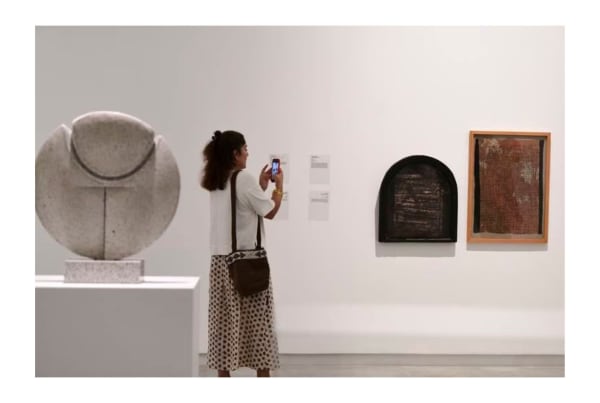Amir Nour Sudanese/American, 1936-2021
Amir Nour (1936-2021) was a Sudanese - American sculptor, born in Shendi, Sudan. His work is a bridge between Western minimalism, Arab and African art, primarily influenced by African sculpture, adobe architecture, Sudanese landscapes (deserts and plains), cattle horns and calabashes. Using arches, geometric and hemispheric shapes, he worked in bronze, stainless steel, moulded plastic, cement and fibreglass.
Known to curators and museum directors, his work has been shown in some of the most significant, epoch-making museum exhibitions of the past 30 years, including The Short Century: Independence and Liberation Movements in Africa, 1945–1994, 2001-2002, curated by Okuwi Enwezor, shown at various institutions in the US and Germany, including MoMA PS1, and Museum Villa Stuck, Munich and Other Primary Structures, curated by Jens Hoffman and Joanna Montaya, at the Jewish Museum, NYC (2014), a sequel to the seminal exhibition Primary Structures, the exhibition that introduced Minimalism to a broad public at the same museum in 1966.
Amir Nour was a Sudanese - American sculptor, born in Shendi, Sudan in 1936. His work is a bridge between Western minimalism, Arab and African art, primarily influenced by African sculpture, adobe architecture, Sudanese landscapes (deserts and plains), cattle horns and calabashes. Using arches, geometric and hemispheric shapes, he worked in bronze, stainless steel, moulded plastic, cement and fibreglass.
Known to curators and museum directors, his work has been shown in some of the most significant, epoch-making museum exhibitions of the past 30 years, including The Short Century: Independence and Liberation Movements in Africa, 1945–1994, 2001-2002, curated by Okuwi Enwezor, shown at various institutions in the US and Germany, including MoMA PS1, and Museum Villa Stuck, Munich and Other Primary Structures, curated by Jens Hoffman and Joanna Montaya, at the Jewish Museum, NYC (2014), a sequel to the seminal exhibition Primary Structures, the exhibition that introduced Minimalism to a broad public at the same museum in 1966.
From the late 1960s, Nour created a new a visual language, combining African-derived forms and a minimalist aesthetic. His early sculptures were produced contemporaneously with those of the major names of Minimalist art, such as Donald Judd, Sol Lewitt and Carl Andre. However, Nour maintained that his work is quite separate from theirs:
“I grew up in an entirely divergent environment, culture and religion...
Yet my work and Western minimalism share the simplicity and purity of forms. My minimalism is rooted in my experience and vision of my culture and history”. The title of his 2016 retrospective at Sharjah Art Foundation “Brevity is the Soul of Wit” (from an Arabic proverb) explains his divergence form Western Minimalism.
Amir Nour received diplomas from the Slade School of Art and the RCA in London, and a BFA and MFA from Yale University. This education introduced him to the vocabulary of the Western modernist tradition, and on the other hand, gave him the opportunity to mix with other non-Western artists and students, a major impetus for the discussion and dissemination of decolonisation.
From 1969 Nour was based in Chicago, where he later taught at the City Colleges. Here he encountered the Civil Rights Movement and had friendships with members of the AfriCobra group and other Chicago-based collectives, and Black sculptors such as Richard Hunt and Melvin Edwards.
Nour’s key exhibitions include African Art Today: Four Major Artists 1974 (Skunder Boghossian, Valente Malangatana, Twins Seven Seven, and Amir I.M. Nour), African-American Institute, New York; Mohamed Omer Khalil Etchings/ Amir I.M. Nour Sculpture 1994 Smithsonian National Museum of African Art, Washington DC; Seven Stories About Modern Art in Africa, 1995 Whitechapel Gallery, London (part of Africa95, a series of exhibitions held at major institutions throughout the UK), curated by Clémentine Deliss (Ethiopia and Sudan section co-curated by Salah M. Hassan); The Short Century: Independence and Liberation Movements in Africa, 1945–1994, 2001-2, MoMA PS1, New York; Museum Villa Stuck, Munich; Museum of Contemporary Art, Chicago, and House of World Cultures, Berlin, curated by Okuwi Enwezor; Other Primary Structures, 2014, Jewish Museum, NYC, a sequel to the seminal 1966 exhibition Primary Structures, the exhibition curated by Jens Hoffman and Joanna Montaya and Amir Nour: Brevity is the Soul of Wit: A Retrospective, 1956-Present, 2016-17 Sharjah Art Foundation, curated by Salah M. Hassan and Hoor Al-Qasimi.
His works are in the public collections of National Museum of African Art, Smithsonian Institution, Washington, D.C, Asilah Municipality, Morocco, City of Chicago
and Sharjah Art Foundation.





